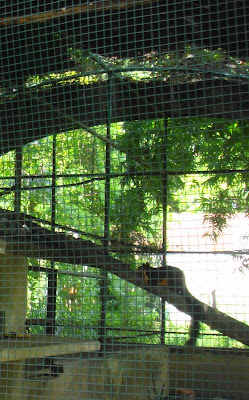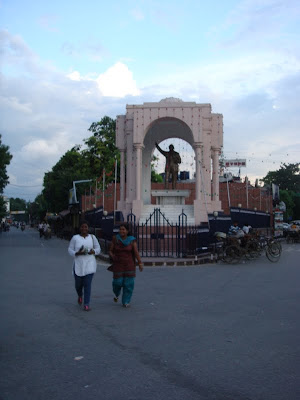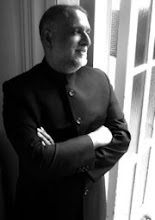Wednesday 31 August 2011
Shining India
Posted by Amrita at Wednesday, August 31, 2011 13 Fertilize my soul
Labels: Photo Diary
Saturday 27 August 2011
Sunday Blessings- Aradhna- Adoration
New King James Version (NKJV)
The Beatitudes
For theirs is the kingdom of heaven.
4 Blessed are those who mourn,
For they shall be comforted.
5 Blessed are the meek,
For they shall inherit the earth.
6 Blessed are those who hunger and thirst for righteousness,
For they shall be filled.
7 Blessed are the merciful,
For they shall obtain mercy.
8 Blessed are the pure in heart,
For they shall see God.
9 Blessed are the peacemakers,
For they shall be called sons of God.
10 Blessed are those who are persecuted for righteousness’ sake,
For theirs is the kingdom of heaven.
11 “Blessed are you when they revile and persecute you, and say all kinds of evil against you falsely for My sake. 12 Rejoice and be exceedingly glad, for great is your reward in heaven, for so they persecuted the prophets who were before you.
We live in an an age where cross-cultural musical projects are a dime a dozen, and all too often they result in a half-baked, watered-down muddle of eclectic instruments banging into each other. The sitar was introduced to rock and roll way before many of us were born. World music has been around long enough to go in and out of style many times over. Western attempts at eastern music is an arena where many more fail than succeed. It’s a road that is fraught with cultural and aesthetic baggage that ensnares all but a few who have managed to produce something worth listening to. Aradhna is among the few who have created a new and enduring sound out of diverse musical traditions of North India and North America.
Somehow, Aradhna has been able to glide past the subterfuge of globalization and establish itself as a band that is genuinely interested in creating cross-cultural dialogue through the arts. They are the real deal and they sing in a bunch of languages and people from all over the world are listening to their music.
In the spring of 2000, Deep Jale′ was recorded, which they decided to release in the U.K. over the course of a three-month tour. Aradhna was born, and the ardent response to their album and performances encouraged them to continue arranging traditional bhajans and begin composing songs of their own for their next release Marga Darshan (2002). After performing extensively in India and North America, Aradhna’s touring expanded to the South Asian Diaspora in South Africa, Guyana and Suriname where East Indians have lived for over a century.
Posted by Amrita at Saturday, August 27, 2011 6 Fertilize my soul
Labels: /Sunday Blessings, /Video
Wednesday 24 August 2011
I want this Poster on the Wall of My House
Posted by Amrita at Wednesday, August 24, 2011 14 Fertilize my soul
Labels: Photos
Tuesday 23 August 2011
In Nature 's Lap - Lucknow Zoo
The Central Zoo Authority, Govt. of India, categorizes the Lucknow Zoo as a large zoo. It has an area of 71.6 acres. It has two veterinarians who look after the health and general up keep of the zoo inmates. The diet is properly checked, sterilized and supplemented with vitamins from time to time. The animals are regularly checked for diseases and worms and preventive and control measures are adopted accordingly.
The Zoo has a newly constructed Nature Interpretation Center where "Touch Table Programmes" are held every Friday for school children. Here, children are given hands-on experience and information about the skins of various animals, eggs of birds/pheasants, tusk of elephants, plaster cast of Tiger pug marks, etc. and also shown one wild life movie. The nature Interpretation Center also houses trophies of various wild animals, a press gallery giving information about the present and past status of the zoo. The site available outside the Nature Interpretation Center is developed as Jurassic Park where different animals/birds, that are extinct or are on the verge of extinction, are displayed in the form of models.
To Provide additional entertainment to the visitors in the Zoo, especially the children, a Toy train was started since 1969. The rolling stock consisting of engine and two coaches is the gift of Railway Board. The train was inaugurated on the Children's Day Nov. 14, 1969 by the then Chief Minister, U. P. the length of the track is 1.5 km. and has crossings and signals. Rides start from Chandrapuri station and this toy train is attracting huge visitors and has proved to be an asset for the zoo over the years.
The initial collection centered around the arts of Avadh and objects related to the customs, habits and mythology of India. Gradually, it expanded to include excavated antiquities from Piparahawa, Kapilavastu, where the Buddha grew up. Today, this has evolved into a multipurpose museum with sculpture, bronzes, paintings, natural history and anthropological specimens, coins, textiles and decorative arts. From the vast number of displayed objects, some hundred are rare and of great value. These include an inscribed wine jar bearing the name of Aurangzeb Alamgir (17th century), a jade chamakali with the name Jahangir and the date 1036 AD, a 16th century painting of a scene from the Kalpasutra depicting an elephant rider and a Jain mum, a 16th century copy of the Harivansha in Persian with nine illustrations, rare silver and gold coins, a prehistoric anthropomorphic figure and a fossilised plant. However, what thrill visitors most are the Egyptian mummy and wooden sarcophagus (1000 BC).
Posted by Amrita at Tuesday, August 23, 2011 9 Fertilize my soul
Labels: Photo Diary
Sunday 21 August 2011
Sunday Blessings - Is Jesus the Only Way?
Jonathan Dodson » God Worldviews Culture Apologetics
Answering the Question Socially
If the answer is: “Yes, Jesus is the only way to God” a line is drawn where we would rather have things remain fuzzy. Why would we prefer this particular claim to fuzziness? In many cities there are an array of religious beliefs: Mysticism, Islam, Buddhism, Hinduism, and Christianity, just to name a few. The presence of so many different religions in cities leads many people (Christians included) to the conclusion that all religious paths lead to God. Why? When we meet people from various religions who are kind and sincere because of their religious beliefs, it seems arrogant to insist they are wrong. After all, their religion appears to have made them very enjoyable, respectable people. I, for one, have met many people I would consider more generous and sacrificial than some Christians I know.
”
A Theological Decision Based on Social Experience
When people of other faiths rival Christian character, we face a tendency to affirm all religions as valid ways to God. We make a theological decision based on social experience. Rather than investigate the answer to one of the most important questions, we prefer to glaze the question with inch-deep reflections upon the character of people we meet. Understandable…but not wise.
What if our generation became known for not only posing great questions but also grappling deeply and sincerely with their answers? Many Christians claim that belief in Jesus is the only way to God. Others insist there are many ways to God. In the next post, I will explore more on why some people insist there are many paths to God.
Posted by Amrita at Sunday, August 21, 2011 6 Fertilize my soul
Labels: Sunday Blessings
Friday 19 August 2011
The City of Princes (Nawabs)- Lucknow
Located in what was historically known as the Awadh region, Lucknow has always been a multicultural city. Courtly manners, beautiful gardens, poetry, music, and fine cuisine patronized by the Persian-loving Shia Nawabs of the city are well known amongst Indians and students of South Asian culture and history. Lucknow is popularly known as the The City of Nawabs. It is also known as the Golden City of the East, Shiraz-i-Hind and The Constantinople of India.
Today, Lucknow is a vibrant city that is witnessing an economic boom and is among the top ten fastest growing non-major-metropolitan cities of India. It is the second largest city in Uttar Pradesh state. The unique combination of its cultured grace and newly acquired pace is its most promising feature that augurs well for the future.
Lucknow is placed among the fastest growing cities and now it is metropolitan city of India and is rapidly emerging as a manufacturing, commercial and retailing hub. This unique combination of rich cultural traditions and brisk economic growth provides Lucknow with an aura that refuses to fade away.
Nawab Asaf-Ud-Dowlah (1775-1797)[11]After 1350 AD the Lucknow and parts of Awadh region have been under the rule of the Delhi Sultanate, the Mughal Empire, the Nawabs of Awadh, the East India Company and the British Raj. Lucknow has been one of the major centers of Indian rebellion of 1857, participated actively in India's Independence movement, and after Independence has emerged as an important city of North India.
Until 1719, subah of Awadh was a province of the Mughal Empire administered by a Governor appointed by the Emperor. Saadat Khan also called Burhan-ul-Mulk a Persian adventurer was appointed the Nazim of Awadh in 1722 and he established his court in Faizabad[12] near Lucknow.
Awadh was known as the granary of India and was important strategically for the control of the Doab, the fertile plain between the Ganges and the Yamuna rivers. It was a wealthy kingdom, able to maintain its independence against threats from the Marathas, the British and the Afghans. The third Nawab, Shuja-ud-Daula fell out with the British after aiding Mir Qasim, the fugitive Nawab of Bengal. He was comprehensively defeated in the Battle of Buxar by the East India Company, after which he was forced to pay heavy penalties and cede parts of his territory. The British appointed a resident in 1773, and over time gained control of more territory and authority in the state. They were disinclined to capture Awadh outright, because that would bring them face to face with the Marathas and the remnants of the Mughal Empire.
Many independent kingdoms, such as Awadh, were established when the Mughal empire disintegrated. Awadh’s capital, Lucknow rose to prominence when Asaf-ud-Daula, the fourth nawab, shifted his court here from Faizabad in 1775. The city was also North India’s cultural capital, and its nawabs, best remembered for their refined and extravagnt lifestyles, were patrons of the arts. Under them music and dance flourished, and many monuments were erected.[13] Of the monuments standing today, the Bara Imambara, the Chhota Imambara, and the Rumi Darwaza are notable examples. One of the more lasting contributions by the Nawabs is the syncretic composite culture that has come to be known as the Ganga-Jamuni Tehzeeb.
Nawab Saadat Khan IIIn 1798, the fifth Nawab Wazir Ali Khan alienated both his people and the British, and was forced to abdicate. The British then helped Saadat Ali Khan to the throne. Saadat Ali Khan was a puppet king, who in the treaty of 1801 ceded half of Awadh to the British East India Company and also agreed to disband his troops in favor of a hugely expensive, British-run army. This treaty effectively made the state of Awadh a vassal to the British East India Company, though it notionally continued to be part of the Mughal Empire in name until 1819.
Wajid Ali Shah (1847 - 1856)[11]In 1856 the East India Company first moved its troops to the border, then annexed the state, which was placed under a chief commissioner - Sir Henry Lawrence. Wajid Ali Shah, the then Nawab, was imprisoned, and then exiled by the Company to Calcutta. In the subsequent Revolt of 1857 his 14-year old son Birjis Qadra son of Begum Hazrat Mahal was crowned ruler, and Sir Henry Lawrence killed in the hostilities. Following the rebellion's defeat, Begum Hazrat Mahal and other rebel leaders obtained asylum in Nepal
Those company troops who were recruited from the state, along with some of the nobility of the state, were major players in the events of 1857. The rebels took control of Awadh, and it took the British 18 months to reconquer the region, months which included the famous Siege of Lucknow. Oudh was placed back under a chief commissioner, and was governed as a British province. In 1877 the offices of lieutenant-governor of the North-Western Provinces and chief commissioner of Oudh were combined in the same person; and in 1902, when the new name of United Provinces of Agra and Oudh was introduced, the title of chief commissioner was dropped, though Oudh still retained some marks of its former independence.
The province of Awadh (anglicized to Oudh) was annexed by the East India Company in 1856 under the Doctrine of Lapse and placed under the control of a chief commissioner. In the Indian Rebellion of 1857 (also known as the First War of Indian Independence and the Indian Mutiny), the garrison based at the Residency in Lucknow was besieged by rebel forces. The famous Siege of Lucknow was relieved first by forces under the command of Sir Henry Havelock and Sir James Outram, followed by a stronger force under Sir Colin Campbell. Today, the ruins of the Residency, and the picturesque Shaheed Smarak offer reminiscences of Lucknow's role in the stirring events of 1857.
Because of its historical importance, commercial activity, and cultural activity, Lucknow has frequently been a center of political activity, prominent in the independence movement. The Lucknow Pact of 1916 was negotiated there, between the Indian National Congress and the Muslim League to support pressuring the Raj for greater autonomy, a marked shift for the Muslim League.
The Khilafat Movement had an active base of support in Lucknow, creating a united platform against the British rule. In the Khilafat Movement Maulana Abdul Bari of Firangi Mahal, Lucknow actively participated and cooperated with Mahatama Gandhi and Maulana Mohammad Ali.
Posted by Amrita at Friday, August 19, 2011 8 Fertilize my soul
Labels: Hello Photos, Streetwise
Wednesday 17 August 2011
Rain washed country side
Posted by Amrita at Wednesday, August 17, 2011 10 Fertilize my soul
Labels: Hello, Photo Diary

































































